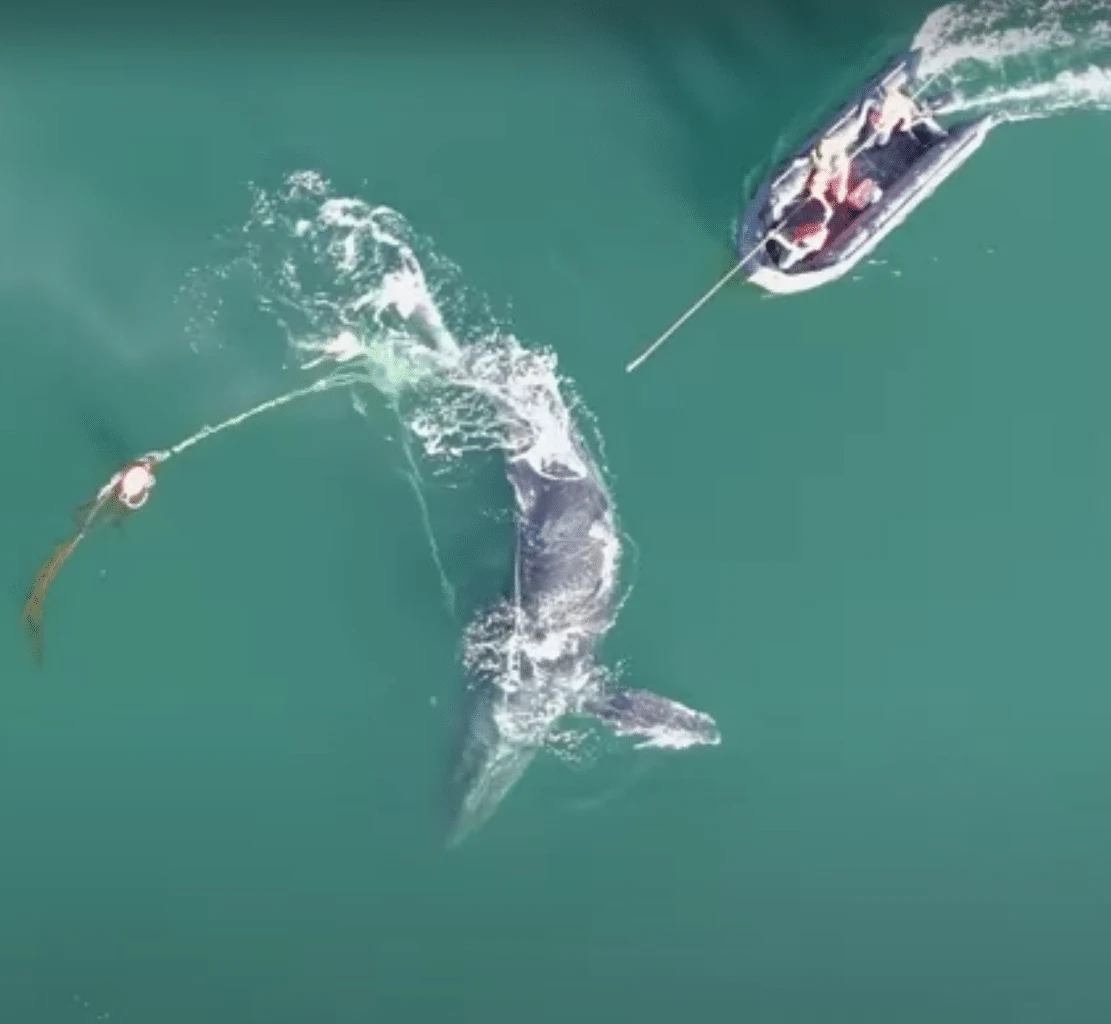In the pristine waters off Gustavus, Alaska, a remarkable and heartwarming rescue mission unfolded, captured by a drone’s unblinking lens. This is the story of a young humpback whale’s struggle for freedom, entangled in the clutches of a 300lb crab pot and heavy ropes. The world watched in awe as the skilled teams worked tirelessly to save this magnificent creature from the brink of disaster.
A Whale in Distress
It all began when two local residents of Gustavus, Alaska, made an astonishing discovery on October 10, 2023. They spotted a humpback whale, around four to five years old, in a dire situation. The whale was entangled in heavy ropes and buoys, anchored to the seafloor by a massive crab pot secured with a 450-foot line.
The residents immediately reported their heart-wrenching find to the visitor information station at Glacier Bay National Park. They described a young humpback whale “trailing two buoys, making unusual sounds, and struggling to move freely.” It was evident that the whale had been ensnared for several days, fighting for its life in the relentless grip of the crab pot.
A Heroic Response
The response was swift and coordinated, involving a dedicated team of experts from the National Park Service (NPS), as well as specialists associated with the Large Whale Entanglement Response network. This wasn’t just a routine rescue mission; it was a race against time to save a life hanging in the balance.
The Power of Drone Imagery
One key element that set this rescue mission apart was the use of advanced technology, specifically drones. The National Oceanic and Atmospheric Administration (NOAA) played a pivotal role in providing valuable insights and assistance to the rescue teams.
With the aid of drone images and photography, the teams were able to gain a deeper understanding of the entanglement and, most importantly, how to prioritize their cutting attempts. Fred Sharpe, an advanced large whale entanglement responder with the Alaska Whale Foundation, emphasized the significance of drone imagery, saying, “The drone imagery assisted tremendously with our understanding of the entanglement and how to prioritize our cutting attempts.”
The Intense Rescue Operation
The drone camera footage allows us a close-up look at the complex and challenging rescue operation. As the rescue teams approached the trapped humpback, they encountered a stubborn adversary. The whale circled and dodged the team for nearly an hour, refusing to yield to their well-intentioned efforts.
Finally, the skilled rescuers managed to initiate the painstaking process of cutting through the entangling ropes. Armed with a special knife, designed with razor blades attached to grappling hooks, on the end of an exceptionally long pole, they began the delicate operation.
The team worked tirelessly throughout the day, fully aware of the dwindling daylight, methodically freeing the whale bit by bit. The humpback, initially cautious and likely confused, gradually realized that it was being set free.

The Moment of Triumph
As the final piece of rope was cut, the world held its collective breath. And then, in a breathtaking moment of pure joy and exhilaration, the young humpback whale bolted into the sea, leaving its tormentors behind. It was a triumphant escape, a victory of nature and human determination against the odds.
A Beacon of Hope
This incredible rescue operation reminds us of the power of human compassion and ingenuity. It also underscores the role technology can play in aiding our efforts to protect and preserve the incredible creatures that inhabit our planet. The successful use of drone imagery in this operation serves as a beacon of hope, demonstrating the potential for innovative solutions to environmental challenges.
The Ongoing Battle
While the story of this humpback whale’s rescue is heartwarming, it also serves as a stark reminder of the ongoing challenges these majestic creatures face. Entanglement in fishing gear, such as crab pots and fishing nets, is a significant threat to the survival of marine mammals.
Conservation efforts and public awareness campaigns are vital in ensuring the safety and well-being of these magnificent creatures. The lessons learned from this rescue operation should inspire us all to work together in protecting the fragile ecosystems of our oceans.
Conclusion
In the waters of Gustavus, Alaska, a drone captured the remarkable rescue of a young humpback whale from the clutches of a 300lb crab pot. This heartwarming and suspenseful story serves as a testament to human determination and the power of advanced technology in safeguarding our planet’s diverse and precious marine life. The successful use of drone imagery in this operation offers a ray of hope and a model for future conservation efforts.
As we celebrate the triumphant escape of this humpback whale, let us not forget the ongoing challenges faced by marine life. Conservation remains an essential mission, and with the right combination of innovation, dedication, and technology, we can continue to protect and preserve the wonders of our oceans.
Up next:
The Best Places to See Humpback Whale
Huge Humpback Whale Surprises Kayaker
Watch: Humpback Whales Breach in Perfect Synchronization
Join our Forum for free today!

- The Kleptomaniac Cat That Rules Houston - July 20, 2024
- Elephant Makes a Lifelong Friend at Sanctuary in Tennessee - July 14, 2024
- Evidence For World’s Oldest Fossilized Forest Discovered in New York - July 11, 2024

